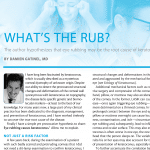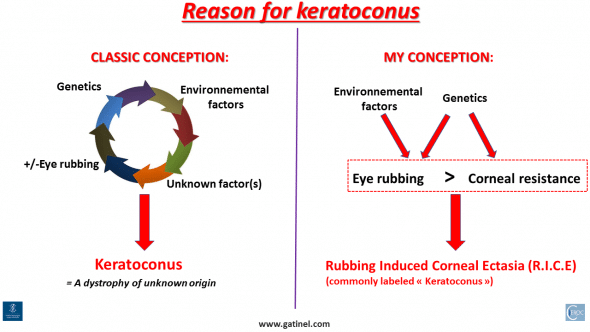Keratoconus, what’s the rub? Cataract and Refractive Surgery Today Eu, April 2017
In this paper, Keratoconus What’s the rub, D Gatinel, CRST Europe, April 2017, I elaborate on the hypothesis that eye rubbing is the root cause of keratoconus. This is a more succinct report of some previously published material pointing toward eye rubbing as prime hit in the keratoconus affection. In my view, keratoconus is not a dystrophy but a mechanically induced corneal condition equivalent to a « Rubbing Induced Corneal Ectasia » (R.I.C.E).
The genetic or environmental factors involved in the keratoconus genesis are because they promote either ocular friction or less corneal resistance (lesser tissue thickness or resistance).
Download PDF : Keratoconus What’s the rub, D Gatinel, CRST Europe, April 2017



Thank you for sharing your story which is compelling. As I often point, all patients monitored for KC have had episodes of chronic vigorous eye rubbing in their personal history. The cause of the rubbing may vary though. Swimming and diving are prone to trigger eye rubbing. In your case with such an intensive swimming practice, the chronic irritation of your ocular mucosae was the cause of the rubbing. It is important to wear sealed goggles when swimming and rinse the ocular surface instead of rubbing in the case of a leak and subsequent local irritation. Your idea of investigating specific subgroups of patients is interesting. We have identified that the people who work at night to be more susceptible to KC (via fatigue and subsequent rubbing). Some sport activities may expose the eyes to be more irritated, as in your case…
Dear Dr. Gatinel,
Je ne parle Français pa bien..
so I will comment in English :)
I am 60 years old. I have KC in both eyes.
Five years ago got Holcomb C3R and Intacs in both my eyes. And CK in my right eye, which had deteriorated badly due to keratoconus.
I think your hypothesis is brilliantly simple (Occam’s Razor).
And operative, in my case, anyway.
History:
*swimming team from age 6-12. Late 60’s, so no concept of swim goggles. Heavily chlorinated pool. I got very red and irritated eyes… Much more so than my 2 siblings. And rubbed them vigorously after each practice.
*at age 16, had better than 20-20 vision on physical exam required to become part of Navy training corps before university.
*at age 18, regular swimming in 3rd year of university. Same issues with chlorine and eye rubbing.
*failed eye test required for Navy aviation physical exam during 4th year of university. Right eye was 20-50.
So I think I got KC from the eye rubbing. And like you state in your hypothesis, the rubbing was the mechanical cause.
That said, there were causes *of the rubbing*:
1. environmental (chlorine exposure) and
2. genetic (my severe reaction to chlorine relative to siblings) factors
These caused *the rubbing*…
Not the KC.
I have had all three of my 22-26 y/o sons tested. None of them have any KC.
And they hated swim team.. but wore goggles.
You may consider a survey of now-older (55-70 years) people — who swam on youth teams.
1. wear goggles? (mostly not, I think)
2. react negatively to the chlorine?
3. rub their eyes?
And.. do they have vision issues?
This would be a pragmatic study that supports your thesis — in a specific genetic/environmental case..
Thank you for your work on Keratoconus, Dr. Gatinel.